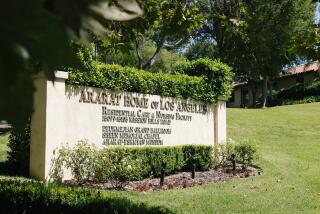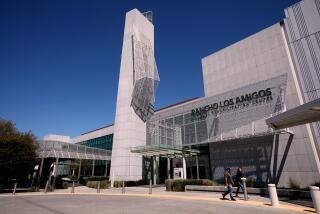Hospitals Fail Nurse Head Count
State regulators discovered that more than half the hospitals they checked were in violation of California’s strict nurse-to-patient ratios, a Times analysis of records found.
The inspection reports indicate that hospitals are having the greatest difficulty meeting ratio requirements in specific departments: emergency rooms, medical-surgical wards and telemetry units where heart patients are monitored.
The state looked into allegations of nurse staffing violations at 28 hospitals between last Jan. 1, when a new state law took effect, and the end of October, the most recent records available.
California was the first state to set standards for the maximum number of patients that a nurse is allowed to handle. The numbers are based on the severity of patients’ illnesses. In an operating room, for example, each patient is required to have a nurse. In a medical-surgical ward, one nurse can care for six patients.
But hospitals have complained that the ratios are impossible to meet. In response, Gov. Arnold Schwarzenegger’s administration last month moved to scale them back. Schwarzenegger wants to give hospitals more flexibility in emergency rooms during unexpected surges of patients. He also wants to delay implementation of a second phase of the law that would further reduce nurse-to-patient ratios.
Of the 28 medical centers inspected, 15 were cited for assigning nurses too many patients. Three were cited for other staffing problems, such as allowing a licensed vocational nurse to perform work that should be handled by a more senior registered nurse. At the other 10 hospitals, state inspectors found no evidence of violations.
Because this was the first year the ratios were in effect, officials said it was difficult to tell whether such problems would persist. The state examines only a small fraction of the more than 400 acute-care hospitals in California for compliance with nurse staffing ratios, dispatching inspectors only when a complaint is filed.
“The regulations were new this year, and there is always a period of adjustment while hospitals and staff implement the requirements,” said Brenda Klutz, deputy director of licensing and certification for the state Department of Health Services.
Unlike cases involving medication errors and patient deaths, hospitals are not required to report violations of the nurse-to-patient ratios.
Most hospitals found to be in violation of the staffing rules had problems in only one ward. At Menifee Valley Medical Center in Sun City, an inspector reported that a review of three days in July showed that, on two out of six shifts, the hospital had failed to provide one nurse for every five patients as required in the telemetry ward.
But six of the 15 hospitals cited over nurse ratios had problems in several wards. Between Jan. 1 and 17 of this year, an inspector found nurse shortages in a variety of wards at John F. Kennedy Memorial Hospital in Indio. They included the telemetry and medical-surgical, critical care, labor and delivery, and the postpartum and pediatric units.
All of the wards had multiple violations, the inspector reported. For instance, 20 of 34 shifts in the emergency room exceeded the ratio of one nurse for four patients.
Five other hospitals in Southern California were cited: County-USC Medical Center in Los Angeles, Riverside County Regional Medical Center in Moreno Valley, Hemet Valley Medical Center in Hemet, Sharp Memorial Hospital in San Diego, and Sharp Mesa Vista Hospital in San Diego.
Hospitals written up for infractions had to submit plans to correct them. The most common solutions proposed were calling in more nurses from independent registries, more aggressively recruiting full-time nurses, and monitoring staffing schedules.
Hospital officials, who have long criticized the law, said the reports showed the difficulty they faced in trying to comply with the ratios.
“What our survey data shows is that 85% of hospitals in the state are not able to comply with the law,” said Jan Emerson, a spokeswoman for the California Healthcare Assn., an industry group. “It’s not because they’re not trying. It’s because there aren’t enough nurses.”
Nursing union officials, who pushed for the ratios, viewed the findings differently.
“I think the fact that there are only 15 hospitals that have been cited is remarkable,” said Jill Furillo, Southern California director of the California Nurses Assn., which lobbied for the ratios in 1999. Furillo said a survey the union conducted earlier this year showed that 58% of hospitals were complying with the law.
“It shows that there were enough nurses available and hospitals hired them,” she said.
The Times’ review of the violation reports showed that hospitals were having particular trouble complying with the ratios during nurses’ work breaks.
An inability to cover breaks was the reason a state inspector found that the two Sharp hospitals in San Diego failed to meet ratios on a handful of days in April, said company spokesman John Cihomsky.
“Nurse staffing ratios, particularly the ‘at all times’ provision, are unrealistic,” he said.
Other hospital officials suggested that medical-surgical wards might be the most common offenders simply because they are the most common wards in hospitals.
A majority of hospitals cited for violations told regulators they planned to get into compliance by bringing in nurses from temporary agencies.
Union officials have expressed concern about that trend, arguing that these “traveling nurses” are not familiar with a particular hospital and need time to get up to speed.
“Hiring [temps] is a short-term, stop-gap measure,” said Mark Tarnawsky, a spokesman for Service Employees International Union Local 660, which represents nurses at Los Angeles County hospitals. “Having nurses not familiar with a particular hospital, constantly rotating through a hospital, is not good for patients.”
But hospital officials say they have little choice but to use temporary nurses.
Emerson of the California Healthcare Assn. said the demand for their services is increasing the salaries of temporary nurses, straining hospital budgets.
“In some situations ... nurses ... are choosing to leave the full-time employed workforce and instead join a registry and go back to the hospital as a registry nurse,” she said.
State regulators say the difficulty hospitals face in meeting the ratios is only one reason they are seeking to modify the requirements.
Klutz, the health department licensing and certification official, said the department consulted with doctors and others and that agency officials were confident that the changes would not affect patient care.
A public hearing on the proposed changes is scheduled Jan. 18 in Sacramento.
*
(Begin Text of Infobox)
Where Nursing Numbers Fell Short
From January to October, records show, the state Department of Health Services cited 15 hospitals for violating nurse-to-patient staffing ratios. Twenty-eight hospitals were checked.
*
* San Joaquin General Hospital, French Camp
* Kindred Hospital -- San Francisco Bay Area, San Leandro
* Dominican Hospital, Santa Cruz
* Community Hospital of the Monterey Peninsula, Monterey
* Enloe Medical Center Esplanade, Chico
* Doctors Hospital of Manteca, Manteca
* Methodist Hospital of Sacramento, Sacramento
* Mercy Medical Center - Community Campus, Merced
* County-USC Medical Center, Los Angeles
* Menifee Valley Medical Center, Sun City
* John F. Kennedy Memorial Hospital, Indio
* Riverside County Regional Medical Center, Moreno Valley
* Hemet Valley Medical Center, Hemet
* Sharp Memorial Hospital, San Diego
* Sharp Mesa Vista Hospital, San Diego
*
Source: California Department of Health Services
*
Los Angeles Times
More to Read
Get the L.A. Times Politics newsletter
Deeply reported insights into legislation, politics and policy from Sacramento, Washington and beyond. In your inbox three times per week.
You may occasionally receive promotional content from the Los Angeles Times.










